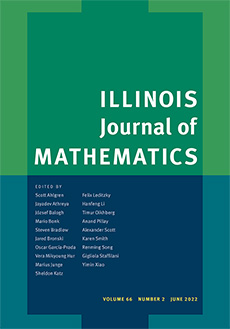Abstract
Let $(G_\ell\mid\ell\in L)$ be a family of groups and let $F$ be a free group. Let $G$ denote $F \ast {\Large{*}}_{\ell\in L} G_\ell$, the free product of $F$ and all the $G_\ell$. Let $\mathcal{F}$ denote the set of all finitely generated (free) subgroups $H$ of $G$ which have the property that, for each $g \in G$ and each $\ell\in L$, $H \cap G_\ell^{g} = \{1\}$. For each free group $H$, the reduced rank of $H$ is defined as $\bar{r}(H) := \max\{\operatorname{rank}(H) -1, 0\} \in[0,\infty]$. Set \begin{eqnarray*} \theta & := & \max\biggl\{ \biggl\vert\frac{\lvert D \rvert}{\lvert D \rvert-2}\biggr\vert : \\ &&{}\mbox{$D$ is a finite subgroup of $G$ with }\lvert D \rvert \ne2 \biggr\} \in [1,3],\\ \sigma & := & \inf\biggl\{ s \in[0,\infty] : \mbox{for all } H, K \in\mathcal{F}, \\ &&{}\sum_{HgK \in H \setminus G /K}\bar{r} (H^g\cap K) \le s {\theta} \bar{r} (H) \bar{r} (K) \biggr\} \in [0,\infty]. \end{eqnarray*} We are interested in precise bounds for $\sigma$. If every element of $\mathcal{F}$ is cyclic, then $\sigma = 0$. We henceforth assume that some element of $\mathcal{F}$ has rank two.
In the case where $G=F$ and, hence, $v = 1$, Hanna Neumann and Walter Neumann proved that $\sigma\in[1,2]$ and it is a famous conjecture that $\sigma = 1$, called the Strengthened Hanna Neumann Conjecture.
For the general case, we proved that $\sigma \in[1,2]$ and if $G$ has 2-torsion then $\sigma = 2$. We conjectured that if $G$ is 2-torsion-free then $\sigma = 1$. In this article, we prove the following implications which show that under certain circumstances $\sigma \lt 2$.
If $G$ is $2$-torsion-free and has $3$-torsion, then $\sigma \le \frac{8}{7}$.
If $G$ is $2$-torsion-free and $3$-torsion-free and has $5$-torsion, then $\sigma \le \frac{9}{5}$.
If $p$ is an odd prime number and $G = C_p \ast C_p$, then $\sigma \le 2 - \frac{(4+2\sqrt{3})p}{(2 p -3 + \sqrt{3})^2}$. In particular, if $G = C_3 \ast C_3$ then $\sigma = 1$, and if $G = C_5 \ast C_5$ then $\sigma \le 1.52$.
Citation
Warren Dicks. S. V. Ivanov. "On the intersection of free subgroups in free products of groups with no $2$-torsion." Illinois J. Math. 54 (1) 223 - 248, Spring 2010. https://doi.org/10.1215/ijm/1299679747
Information





